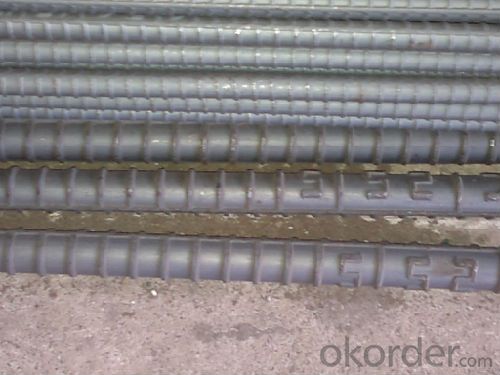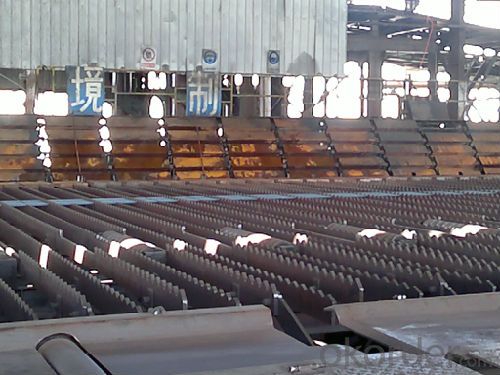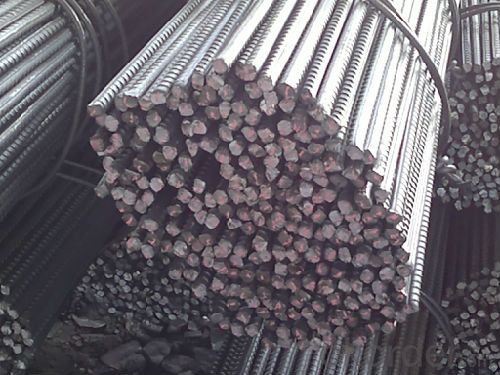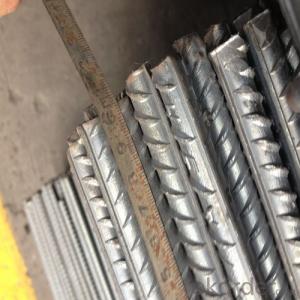Deformed Steel Bar HRB4000 HRB500 ASTM A615 GR40/GR60
- Loading Port:
- Tianjin
- Payment Terms:
- TT or LC
- Min Order Qty:
- 100 m.t.
- Supply Capability:
- 40000 m.t./month
OKorder Service Pledge
OKorder Financial Service
You Might Also Like
Product Description:
OKorder is offering Deformed Steel Bar HRB4000 HRB500 ASTM A615 GR40/GR60 at great prices with worldwide shipping. Our supplier is a world-class manufacturer of steel, with our products utilized the world over. OKorder annually supplies products to European, North American and Asian markets. We provide quotations within 24 hours of receiving an inquiry and guarantee competitive prices.
Product Applications:
Deformed Steel Bar HRB4000 HRB500 ASTM A615 GR40/GR60 are ideal for structural applications and are widely used in the construction of buildings and bridges, and the manufacturing, petrochemical, and transportation industries.
Product Advantages:
OKorder's Deformed Steel Bar HRB4000 HRB500 ASTM A615 GR40/GR60 are durable, strong, and resist corrosion.
Main Product Features:
· Premium quality
· Prompt delivery & seaworthy packing (30 days after receiving deposit)
· Corrosion resistance
· Can be recycled and reused
· Mill test certification
· Professional Service
· Competitive pricing
Product Specifications:
Standard | GB | HRB400 | |
Diameter | 6mm,8mm,10mm,12mm,14mm,16mm,18mm,20mm, 22mm,25mm,28mm,32mm,36mm,40mm,50mm | ||
Length | 6M, 9M,12M or as required | ||
Place of origin | Hebei, China mainland | ||
Advantages | exact size, regular package, chemical and mechanical properties are stable. | ||
Type | Hot rolled deformed steel bar | ||
Brand name | DRAGON | ||
Chemical Composition: (Please kindly find our chemistry of our material based on HRB500 as below for your information)
Grade | Technical data of the original chemical composition (%) | ||||||
C | Mn | Si | S | P | V | ||
HRB400 | ≤0.25 | ≤1.60 | ≤0.80 | ≤0.045 | ≤0.045 | 0.04-0.12 | |
Physical capability | |||||||
Yield Strength (N/cm²) | Tensile Strength (N/cm²) | Elongation (%) | |||||
≥400 | ≥570 | ≥14 | |||||
Theoretical weight and section area of each diameter as below for your information:
Diameter(mm) | Section area (mm²) | Mass(kg/m) | Weight of 12m bar(kg) |
6 | 28.27 | 0.222 | 2.664 |
8 | 50.27 | 0.395 | 4.74 |
10 | 78.54 | 0.617 | 7.404 |
12 | 113.1 | 0.888 | 10.656 |
14 | 153.9 | 1.21 | 14.52 |
16 | 201.1 | 1.58 | 18.96 |
18 | 254.5 | 2.00 | 24 |
20 | 314.2 | 2.47 | 29.64 |
22 | 380.1 | 2.98 | 35.76 |
25 | 490.9 | 3.85 | 46.2 |
28 | 615.8 | 4.83 | 57.96 |
32 | 804.2 | 6.31 | 75.72 |
36 | 1018 | 7.99 | 98.88 |
40 | 1257 | 9.87 | 118.44 |
50 | 1964 | 15.42 | 185.04 |
Usage and Applications of HRB400 Deformed Steel Bar:
Deformed bar is widely used in buildings, bridges, roads and other engineering construction. Big to highways, railways, bridges, culverts, tunnels, public facilities such as flood control, dam, small to housing construction, beam, column, wall and the foundation of the plate, deformed bar is an integral structure material. With the development of world economy and the vigorous development of infrastructure construction, real estate, the demand for deformed bar will be larger and larger..
Packaging & Delivery of HRB400 Deformed Steel Bar:
Packaging Detail: products are packed in bundle and then shipped by container or bulk vessel, deformed bar is usually naked strapping delivery, when storing, please pay attention to moisture proof. The performance of rust will produce adverse effect.
Each bundle weight: 2-3MT, or as required
Payment term: TT or L/C
Delivery Detail: within 45 days after received advanced payment or LC.
Label: to be specified by customer, generally, each bundle has 1-2 labels
Trade terms: FOB, CFR, CIF
FAQ:
Q1: Why buy Materials & Equipment from OKorder.com?
A1: All products offered byOKorder.com are carefully selected from China's most reliable manufacturing enterprises. Through its ISO certifications, OKorder.com adheres to the highest standards and a commitment to supply chain safety and customer satisfaction.
Q2: How do we guarantee the quality of our products?
A2: We have established an advanced quality management system which conducts strict quality tests at every step, from raw materials to the final product. At the same time, we provide extensive follow-up service assurances as required.
Q3: How soon can we receive the product after purchase?
A3: Within three days of placing an order, we will begin production. The specific shipping date is dependent upon international and government factors, but is typically 7 to 10 workdays.
Q4: What makes stainless steel stainless?
A4: Stainless steel must contain at least 10.5 % chromium. It is this element that reacts with the oxygen in the air to form a complex chrome-oxide surface layer that is invisible but strong enough to prevent further oxygen from "staining" (rusting) the surface. Higher levels of chromium and the addition of other alloying elements such as nickel and molybdenum enhance this surface layer and improve the corrosion resistance of the stainless material.
Q5: Can stainless steel rust?
A5: Stainless does not "rust" as you think of regular steel rusting with a red oxide on the surface that flakes off. If you see red rust it is probably due to some iron particles that have contaminated the surface of the stainless steel and it is these iron particles that are rusting. Look at the source of the rusting and see if you can remove it from the surface.
Images:



- Q:Can steel rebars be used in structures with high thermal insulation requirements?
- No, steel rebars are not suitable for structures with high thermal insulation requirements. Steel is a good conductor of heat, so it would significantly reduce the effectiveness of thermal insulation in such structures.
- Q:4E DG 164 is a steel grade 3 steel, DG steel, E is what mean
- E is the mark of the steel band seismic! Commonly known as: with E steel, or earthquake resistant steel!
- Q:How are steel rebars used in the construction of chemical processing plants?
- To reinforce and strengthen chemical processing plants, steel rebars are commonly employed. These rebars, also known as reinforcing bars, are typically crafted from carbon steel and are utilized to fortify various concrete structures like foundations, walls, columns, and beams. Considering the handling of hazardous and corrosive substances in chemical processing plants, the infrastructure is subjected to significant stress. Therefore, the utilization of steel rebars is of utmost importance as it safeguards the integrity of the structures and mitigates the risk of collapse or failure. When constructing chemical processing plants, it is customary to embed steel rebars within the concrete to create a reinforced concrete structure. This amalgamation of concrete and steel rebars forms a composite material that possesses augmented tensile strength, enabling it to endure the heavy loads, vibrations, and extreme temperature fluctuations frequently encountered in chemical plants. Furthermore, the deployment of steel rebars aids in averting cracks and structural deformations caused by shrinkage, settling, or external forces. This is particularly critical in chemical processing plants, where maintaining a secure and stable environment is imperative for employee safety and the plant's operational integrity. Moreover, steel rebars exhibit exceptional resistance to corrosion, a crucial attribute in chemical processing plants where exposure to corrosive chemicals and high humidity levels is prevalent. By serving as a protective barrier for the underlying concrete, steel rebars effectively prevent deterioration induced by corrosion, thereby prolonging the lifespan of the structures and reducing maintenance expenses. Overall, the presence of steel rebars assumes a vital role in the construction of chemical processing plants as they ensure structural stability, durability, and corrosion resistance, all of which are essential for the safe and efficient functioning of these facilities.
- Q:How do steel rebars contribute to the overall resistance against natural disasters?
- Steel rebars contribute to the overall resistance against natural disasters in various ways. Firstly, steel rebars are extensively used in reinforced concrete structures such as buildings, bridges, and dams, which are designed to withstand natural disasters like earthquakes and hurricanes. The addition of steel rebars increases the structural integrity of these concrete elements, making them more resistant to the forces exerted by such disasters. During earthquakes, the flexible nature of steel rebars allows them to absorb and distribute the seismic energy throughout the structure. This helps in dissipating the destructive forces and reducing the chances of collapse or severe damage. The presence of steel rebars also enhances the ductility of reinforced concrete structures, which means they can deform and flex without breaking, thus improving their overall resilience against seismic events. In the case of hurricanes or strong winds, steel rebars provide additional strength and stability to concrete structures. They act as reinforcement, preventing the concrete from cracking or crumbling under the pressure of high winds. The combination of the tensile strength of steel and the compressive strength of concrete creates a robust and durable structure that can withstand the powerful forces generated by hurricanes. Furthermore, steel rebars play a crucial role in the construction of flood-resistant structures. During flooding events, the strength and corrosion resistance of steel rebars ensure the structural integrity of buildings and other infrastructure, preventing them from being severely damaged or washed away. The use of steel rebars in flood-prone areas helps in creating resilient structures that can withstand the erosive forces of water and remain intact. Overall, steel rebars significantly contribute to the overall resistance against natural disasters by enhancing the strength, durability, and flexibility of concrete structures. Their presence improves the structural integrity and resilience of buildings, bridges, and other infrastructure, making them more capable of withstanding the destructive forces unleashed by earthquakes, hurricanes, and floods.
- Q:How can corrosion of steel rebars be prevented?
- Corrosion of steel rebars can be prevented through various methods such as using corrosion-resistant materials, applying protective coatings, ensuring proper concrete cover, implementing cathodic protection systems, and maintaining a good drainage system to avoid water accumulation. Regular inspection and maintenance also play a crucial role in preventing corrosion.
- Q:Are there any disadvantages to using steel rebars?
- Yes, there are some disadvantages to using steel rebars. Firstly, steel rebars can corrode over time, especially in environments with high moisture or exposure to chemicals, which can reduce their strength and durability. Additionally, steel rebars are susceptible to thermal expansion and contraction, leading to cracking in concrete structures. Moreover, steel rebars are heavy and can be challenging to handle and transport, making construction processes more labor-intensive.
- Q:Can steel rebars be used in cold weather conditions?
- Yes, steel rebars can be used in cold weather conditions. Steel is known for its durability and strength, making it a suitable material for construction projects even in cold climates. However, it is important to take certain precautions when using steel rebars in cold weather. For instance, the rebars should be properly stored and protected from moisture to prevent rusting. Additionally, the concrete mix used with the rebars should be adjusted to ensure it can withstand freezing temperatures and avoid cracking. Overall, with proper planning and precautions, steel rebars can be effectively used in cold weather conditions.
- Q:Can steel rebars be used in structures with high vibrations?
- Yes, steel rebars can be used in structures with high vibrations. Steel rebars have excellent mechanical properties, including high tensile strength and durability, making them suitable for reinforcing structures that experience vibrations. Additionally, steel rebars provide stability and help to distribute the vibrations throughout the structure, reducing the risk of failure due to excessive movement.
- Q:How are steel rebars protected against extreme weather conditions?
- Steel rebars are protected against extreme weather conditions through various methods such as epoxy coating, galvanization, and concrete cover. These protective measures prevent corrosion and degradation of the rebars, ensuring their durability and strength even in harsh weather conditions.
- Q:How are steel rebars protected from corrosion in marine environments?
- Steel rebars are protected from corrosion in marine environments through various methods such as using epoxy-coated rebars, applying corrosion inhibitors, or using stainless steel rebars that are inherently resistant to corrosion.
1. Manufacturer Overview |
|
|---|---|
| Location | |
| Year Established | |
| Annual Output Value | |
| Main Markets | |
| Company Certifications | |
2. Manufacturer Certificates |
|
|---|---|
| a) Certification Name | |
| Range | |
| Reference | |
| Validity Period | |
3. Manufacturer Capability |
|
|---|---|
| a)Trade Capacity | |
| Nearest Port | |
| Export Percentage | |
| No.of Employees in Trade Department | |
| Language Spoken: | |
| b)Factory Information | |
| Factory Size: | |
| No. of Production Lines | |
| Contract Manufacturing | |
| Product Price Range | |
Send your message to us
Deformed Steel Bar HRB4000 HRB500 ASTM A615 GR40/GR60
- Loading Port:
- Tianjin
- Payment Terms:
- TT or LC
- Min Order Qty:
- 100 m.t.
- Supply Capability:
- 40000 m.t./month
OKorder Service Pledge
OKorder Financial Service
Similar products
New products
Hot products
Related keywords





























